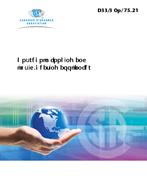Click here to purchase
Preface
This is the seventh edition of CSA C22.2 No. 64, Household cooking and liquid-heating appliances, one of a series of Standards issued by the Canadian Standards Association under the Canadian Electrical Code, Part II. It supersedes the previous editions, published in 1991, 1980, 1976, 1972, 1954, and 1936.
Scope
1.1This Standard applies to cord-connected and permanently connected cooking and liquid-heating appliances* rated for use on nominal single-phase system voltages of 240 V and less and designed to be used in nonhazardous locations in household and similar applications in accordance with the Rules of the Canadian Electrical Code, Part I.*The abbreviated term “appliance” is used in this Standard.
1.2The Standard applies to kitchen-type cooking and liquid-heating appliances such as bottle warmers; bun warmers; broilers; chafing dishes; coffee-, crepe-, and doughnut-makers; coffee stoves; corn poppers; deep-fat fryers; egg-, hamburger-, hot-dog-, pressure-, and slow-cookers; frypans; griddles; grills; hot carts; hotplates; kettles; liquid heaters; rangettes; sandwich toasters; table ovens; toaster ovens; toasters; tureens; waffle irons; warming trays and plates; and similar appliances.
1.3This Standard applies to miscellaneous equipment such as aquarium heaters, barbecues, barbecue lighters, facial saunas, incineration and humus (or chemical) types of electric toilets, poultry water heaters, stock water heaters, vaporizers, water heaters (other than the storage type), water distillers, and similar equipment.
1.4This Standard does not apply to electric ranges, instrument sterilizers, commercial cooking appliances, storage-tank-type water heaters, insecticide vaporizers, industrial liquid heaters, hair-dressing equipment, or equipment covered by other Standards under the Canadian Electrical Code, Part II.
1.5In CSA standards, “shall” is used to express a requirement, i.e., a provision that the user is obliged to satisfy in order to comply with the standard; “should” is used to express a recommendation or that which is advised but not required; and “may” is used to express an option or that which is permissible within the limits of the standard.Notes accompanying clauses do not include requirements or alternative requirements; the purpose of a note accompanying a clause is to separate from the text explanatory or informative material.Notes to tables and figures are considered part of the table or figure and may be written as requirements.Annexes are designated normative (mandatory) or informative (non-mandatory) to define their application.
1.6The values given in SI units are the units of record for the purposes of this Standard. The values given in parentheses are for information and comparison only.
Product Details
- Published:
- 03/01/2010
- ISBN(s):
- 9781554913992
- Number of Pages:
- 78
- File Size:
- 1 file , 2 MB
- Product Code(s):
- 2420624, 2420624
